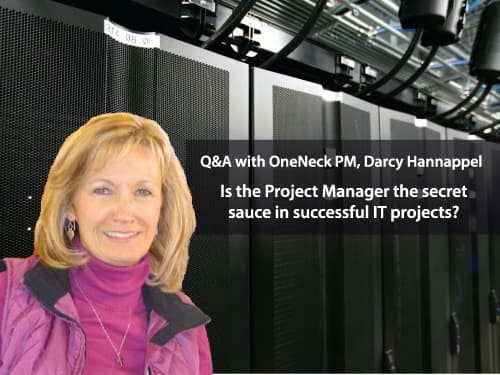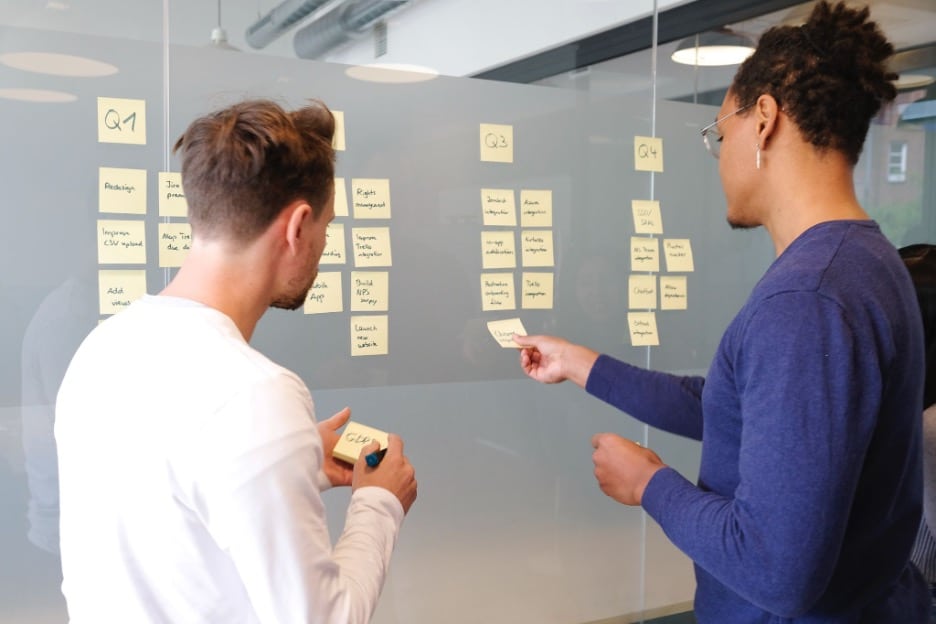Professional IT Project Management | Q&A with Darcy Hannapp

A large IT project can get complicated quickly. The PM has to own the project, manage the customer requirements, scope, resources, schedules, budgets, and communicate, communicate, communicate to ensure that we meet the customer business objectives. That’s why it’s essential to have an effective go-to point person on your team—an invaluable project manager (PM).
I recently sat down with Darcy Hannappel, OneNeck Practice Manager in our Project Management Organization, to get her take on the PM’s role in our project success.
Describe for me the PM’s role in a complex IT project.
The PM’s role is really to coordinate everything. We’re the single point of contact from the moment the project comes in the door, it is assigned to a PM, and they’re off and running. They have to pull the resources together. They send a customer intro letter saying, “Hey, I’m your PM on this project – any issues, let me know. I’m going to work with you to set up a kickoff, get our teams assigned and scheduled.” So, they’re it – the single point of contact for that project.
I can imagine that working closely with key stakeholders of a project, customers or OneNeck team members, can get challenging sometimes. How do you ensure that the right level of communication is happening so everyone has opportunity for input, but still keep the project moving forward?
We have a predefined methodology, and there are key performance indicators (KPIs) that our PMs are expected to comply with. For example, once a project is assigned, the PM has 24 hours to respond to the account executive (AE), and 48 hours to reach out to the customer to let them know, “I am your PM.”
As a PM practice manager, we look at KPIs in the system, because the projects are all entered into our tracking tools. So, we know exactly when they kick off the project, I know who the team is, and we know what status meetings are scheduled. Then once the project is kicked off, at a minimum, they have weekly status updates with the entire team – customer and internal.
We have standard templates for notes they’re required to take. We have SharePoint sites that we put all of our collaboration docs in. We schedule regular status meetings with the customer and team to ensure constant communications
So, we’ve got a pretty good standard methodology that all the PMs comply with. This assures us that every customer is treated the same way and receives all of the information they need. The AMs receive all the information. And our documents look and feel the same, no matter what the customer project.
Is this a process that we, OneNeck, has defined, or is it standard?
Kind of standard, but with we being the hybrid IT provider we are with professional services projects, with managed services projects and with a conglomerate of other projects, we took the standard methodology and we customized it.
Can you give me an example of a project OneNeck has done that a PM played an integral role in its success?
There are so many. But one of the big ones that we just wrapped up was for a major car manufacturer that was moving their headquarters to a different state. We were tasked with building out their entire network in the new location. And we had at one time, upwards of 10 network engineers on the project, so there was a huge coordination effort between the gear that shipped to OneNeck’s warehouse and getting it dispersed as the campus was being constructed, onto each site as it was ready for us to come into it with the gear. So, there was a huge coordination effort with the customer’s engineers, with the construction folks and with our team to build a schedule out. And even with our warehouse personnel to ship the gear at the right time and even have the right people on the ground to install it when it showed up. This was an 18-month project, and it was a huge success.
A large, well-known city is another one. They’re a constant managed services customer that has been with OneNeck for quite a long time, and we’re constantly doing migrations and upgrades for them. We have a program manager, since it is so large, and at least 2 PMs reporting underneath them. They report through custom dashboards to the customer on a weekly basis, sometimes 2x week, depending on what’s going on. These PMs are on board, in touch all the time – a stellar example of great project management. There are so many moving parts and pieces to these managed services customers, not to mention the new projects coming it, and of course giving them the customer service that they expect from us, and so far, we’ve been on the mark.
What crucial skills do you think makes a good PM?
Number 1 – communication. 90% of our job is communicating. You have to be able to communicate in person or virtually thru webex sessions. You have to be able to communicate so precisely, and to blend your communication style with your audience. It could be with a high-level exec at a customer, or maybe one of our very technical engineers that are on the ground doing the nuts-n-bolts work. So, communication skills are an absolute #1.
Number 2 would be the ability to juggle lots of things, and doing it effectively and efficiently – as well as switching gears quickly.
Being technical is really pretty key. We’ve got to have enough knowledge to talk to very technical people at their level. If you don’t, you get the same level of engagement. So, you have to have the aptitude to pick stuff up quickly and put the pieces together real time.
Our PMs are incredible. I don’t know how they manage all of what they do, but they do. They stay on top of all of it.
You’ve been at OneNeck for many years. How have you seen the role of the PM evolve with the industry?
In the old days, we used to install gear, turn up the customer, hand it off to them, and then said, “Let us know when you need an upgrade.” Those days are over. Now the customers come to us and say, “I need you, in your data centers, to run my IT infrastructure.” So, as a PM, we’ve had to blow out our knowledge base and embrace the fact that we’re that customer’s IT department: we’re monitoring, we’re backing up, we’re patching, we’re the middleman for multiple vendors, we’re doing it all.
The amount of technology we deal with is mind blowing. For example, migrating a customer from on-prem to ReliaCloud. Fifteen years ago, I would have said, “How do you spell that?” Today, the brain automatically starts going, okay, you need monitoring, you need data center, you need servers, you need, you need monitoring and network, all of these parts and pieces. It’s evolved into such a hybrid skillset.
So, today’s PM has to interface with every single one of those areas and understand what piece comes first, where the dependencies are, or where there might be a missing link. So, we’re often the ones mid-stream that figure out something’s missing, and thankfully, we have some incredible tools that help us manage these complex projects. But, like anything, the tools are only as good as the people putting the data in them, so the PMs are even more key than the tools.
The engineers rely on us, to build a schedule, to keep the customer informed, to know what needs to be done and to understand dependencies. So, it’s a huge responsibility. But, I’ll tell you what, we’ve got an incredible team of PMs.
And, honestly, it’s exciting. If you are bored with what you’re doing because you’re not learning anything new, then come be a PM. I guarantee you, every day you’re going to learn something new.
Anything in conclusion?
Customer is FIRST. If we don’t have a happy customer, we don’t have a successful project. If that customer isn’t going to look back in the end and say, “Wow, you guys did a great job,” then we fell short somewhere. So, the customer is first and foremost in every PM’s mind.




